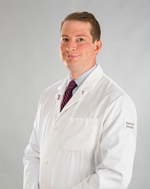Dr. Adam Lindsay
Orthopaedic Oncology
Hartford HealthCare Bone & Joint Institute at Hartford Hospital

Bone and soft tissue sarcomas are a rare group of malignancies.
It is estimated 15,000 to 20,000 new sarcomas will be diagnosed in the United States annually, representing less than 1 percent of all new cancer diagnoses. There have been more than 50 subtypes of sarcoma. These tumors can arise in a number of areas of the body, but are commonly diagnosed in the arms and legs.
Some sarcomas appear in muscle, fat or other connective tissues. Some sarcomas appear in the bone. Sarcomas are diagnosed at all ages, including in childhood and late in life. Soft tissue and bone sarcomas unfortunately are relatively more common in children, representing the sixth- and seventh-most common cancer diagnosis in the pediatric population.
They often appear as rapidly growing painless tumors when involving the soft tissues, and present with pain when involving the bone.
The Bone & Joint Institute at Hartford Hospital and the Hartford HealthCare Cancer Institute frequently work together in the diagnosis and treatment of bone and soft tissue sarcomas.
Treatment
The treatment of sarcomas of the arms and legs has evolved significantly over the past several decades. Because these tumors are relatively rare, present at different ages and in different locations within the body, it can be expected that there is some variability in the way they’re treated.
Successful treatment is dictated by early detection of the tumor, and prompt referral to a hospital that has experience with treatment of these rare malignancies. Medical expertise in surgery, radiation therapy and chemotherapy have led to new treatment options. But the mainstay treatment is to remove them surgically.
The most impressive surgical advances have been seen in the field of limb-salvage surgery, or surgery that removes the tumor without the need for amputation.
Diagnosis
Historically, a diagnosis of a sarcoma involving the arms or legs often meant an amputation. Surgeons and oncologists were concerned that anything less than an amputation high above the location of the sarcoma could result in the tumor coming back (local recurrence) or even spreading (metastatic disease).
Limitations in imaging technologies left surgeons guessing whether the tumor was involving important structures such as blood vessels, nerves, joints or bone critical for limb function. Also, alternative or adjunctive treatments such as chemotherapy or radiation were lacking.
These adjuvant treatments might allow a surgeon to operate closer to the tumor and decrease the chance of local recurrence. As a result, amputations were common, and patients were left with significant dysfunction.
Imaging and Radiation
With advances in imaging techniques, surgeons can now clearly see the anatomy and location of these tumors. This allows us to make plans for operations to remove these tumors and leave behind vital structures, hence salvaging the limb.
Collaborations with other surgeons with expertise in vascular surgery, surgical oncology and neurosurgery have allowed teams to work to preserve the limb, while still providing an adequate removal of the tumor. Multiple research studies have helped us to learn that we can remove these tumors with closer margins. This means minimal muscle, bone or other connective tissue is removed at the time of surgery, which again preserves function for the arm or leg.
Advances in radiation therapy help as well. Adding radiation therapy to the treatment of a limb sarcoma, either before or after surgery, can help to decrease local recurrence rates and again allows surgeons to work closer to these tumors.
Our experienced pathologists are finding new ways to diagnose and classify these tumors, which has allowed for a better understanding of which sarcoma subtypes may respond to a chemotherapy or targeted therapy medication, and which are better candidates for surgery.
Surgery
Inevitably, sarcomas of the arms and legs need surgery, and large portions of bone or muscle may need to be removed with the tumor. Over time, orthopaedic surgeons, who specialize in bone, joint and soft tissue surgery, have become more involved in the care of these patients.
There are now many advancing techniques for the orthopaedic surgeon performing limb salvage. For instance, removing a large portion of a bone involved by a sarcoma can be difficult and requires complicated reconstruction.
An orthopaedic surgeon might decide to use a bulk allograft, which is a segment of cadaver bone, taken from another patient who has passed away, that is matched to fit the bone that has been removed because of the sarcoma. In a sense, this is similar to an organ transplant, such as kidney or liver.
Many options are also available for prosthetic replacement, meaning a customizable metal bone can be implanted to restore function. We now have the option to replace entire bones and their adjacent joints, including total femoral replacement (hip thigh and knee) or total humeral replacement (shoulder, arm and elbow).
Bones can even be taken from one part of a patient’s body and moved to the area of the sarcoma to fill the gap where bone was removed. For instance, a segment of the fibula bone (the small bone in the leg connecting the knee and ankle) can be used to fill a gap in a patient’s thigh or arm bones.
We have seen great strides in the treatment of this rare type of cancer. As always, more progress is needed. We hope that better diagnosis and a better understanding of the genetics of sarcoma will allow us to generate more individualized treatments for patients.
We hope that surgery someday will take a back seat to less invasive therapies such as medical therapies, targeted therapies and radiation therapies. We have learned how to safely avoid amputation in the majority of sarcoma patients, but we understand there are endless opportunities for the improvement of limb salvage surgery.
The need for more durable limb reconstructions that can be performed while minimizing complications for the patient cannot be overstated. The additional assistance of physiatry (rehabilitation medicine), physical therapy and other specialists have also helped patients to recover function and well-being.
We have developed a prolific sarcoma treatment team here at Hartford Hospital. For a patient with a new diagnosis of a rare malignancy, such as sarcoma, it can be difficult to find a team of providers with the expertise and comfort needed to provide them the best of care.
Hartford Hospital, with the Bone & Joint Institute, is offering all of that expertise and the latest in sarcoma therapy and limb salvage surgery.


